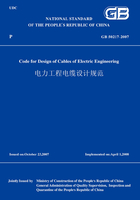
3.4 Type of Cable Insulation
3.4.1 The type of cable insulation shall be selected in accordance with the following requirements:
1 The service life of cable insulation under working voltage,current and characteristic and ambient conditions shall not be less than the normally expected life.
2 The cable insulation shall be selected by considering factors including reliable operation,easy construction and maintenance and highest permissible working temperature as well as manufacturing costs.
3 The cable insulation shall meet the requirements on fire protection and ensure safety.
4 Where it is explicitly specified that the cable insulation is in harmony with environmental protection,the cable insulation used shall be environmentally friendly.
3.4.2 The type of insulation of ordinary cables shall be selected according to the following requirements:
1 The type of insulation of LV and MV cables shall be selected according to Articles 3.4.3-3.4.7 of this code.In addition,for LV cables,extruded PVC or XLPE insulation should be used,and for MV cables,XLPE insulation should be used.
Whereit is explicitly specified that the cable insulation is in harmony with environmental protection,the use of polyethylene insulated cables is not allowed.
2 The insulation of cables used in HV AC systems should be of XLPE type.In areas where rich operation experiences are available,self-contained oil-filled cables may be used.
3 For HVDC transmission systems,self-contained oil-filled cables with non-draining impregnated paper insulation may be used.Where high transmission capacity is required,the insulation should be of semi-synthetic paper type.
For DC transmission systems,ordinary XLPE cables should not be used.
3.4.3 In circuits where frequent bending occurs or requirements on high flexibility is placed,such as those of mobile electrical equipment,rubber insulated cables shall be used.
3.4.4 At locations under the action of radiation rays,cables with high radiation resistance,such as those with XLPE or EPR insulation,shall be selected according to the requirements on insulation type.
3.4.5 At 60℃or above high temperature locations,heat resistant cables with PVC,cross-linked PE or EPR insulation shall be selected based on the high temperature they experience and the duration of the high temperature as well as the requirements on insulation type;in high temperature environments of above 100℃,mineral insulated cables should be used.
Athigh temperature locations,ordinary polyethylene insulated cables should not be used.
3.4.6 In low temperature environment below-15℃,cables with XLPE,polyethylene or cold-resistant rubber insulation shall be selected according to the temperature they experience and the requirements on insulation type.
PVC insulated cables should not be used under low temperature.
3.4.7 In public facilities that are densely populated and at locations where cables are required to be fire retardant and low toxic,XLPE or EPR insulated cables free of halide can be used.
Where low toxic fire protection is required,PVC cables should not be used.
3.4.8 For circuits of below 6kV,PVC insulated cables may be used unless otherwise clearly specified in Articles 3.4.5-3.4.7 of this code.
3.4.9 For major 6kV circuits or XLPE cables of above 6kV,the process of co-extruding the inner semiconductive layer,outer semi-conductive layer and insulation layer together shall be adopted.